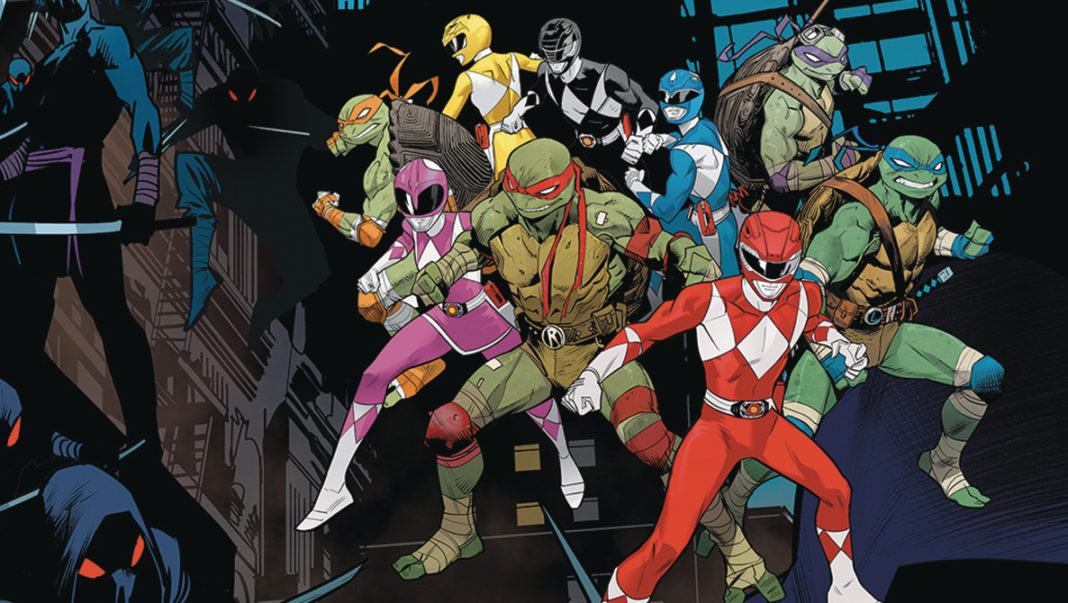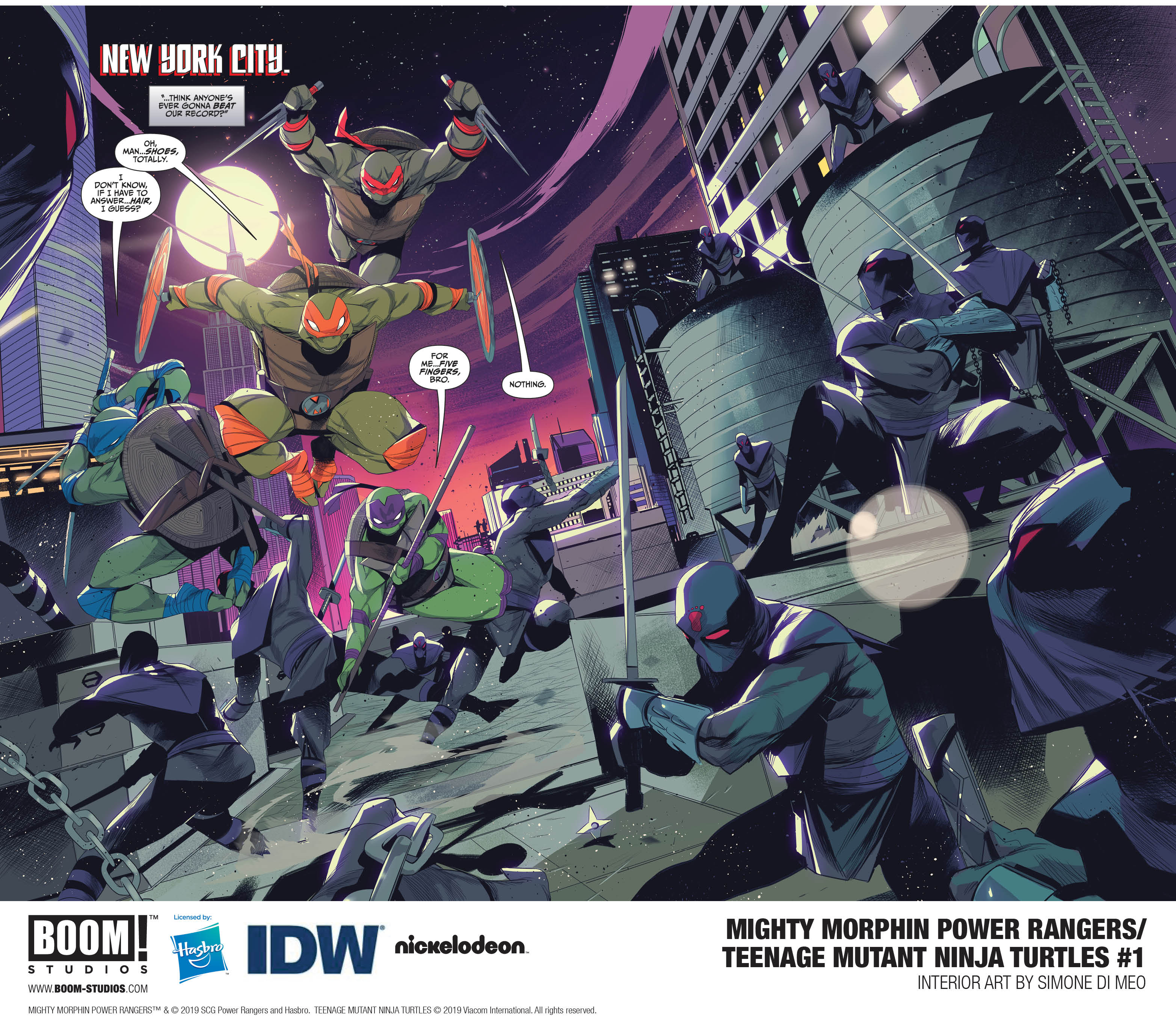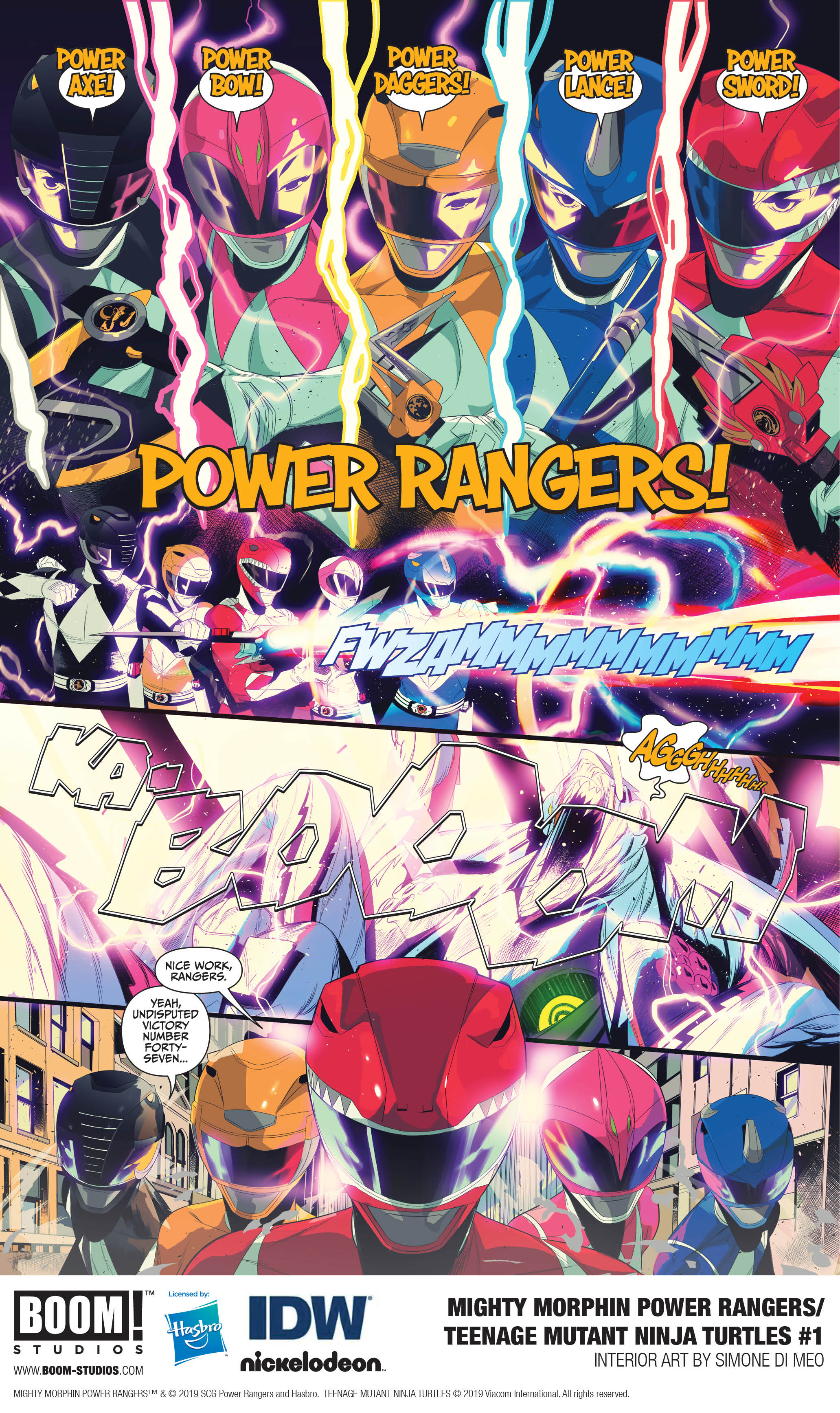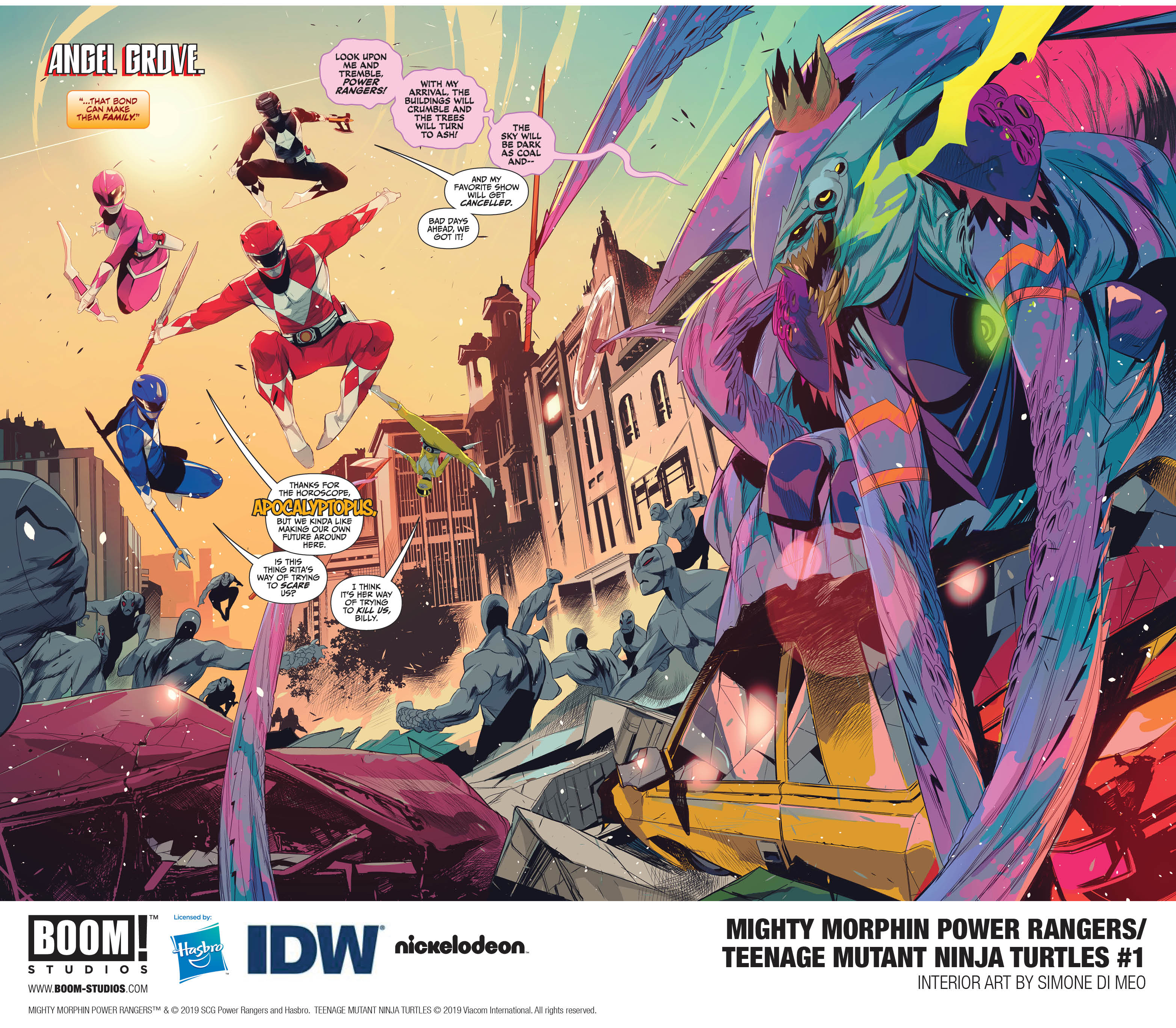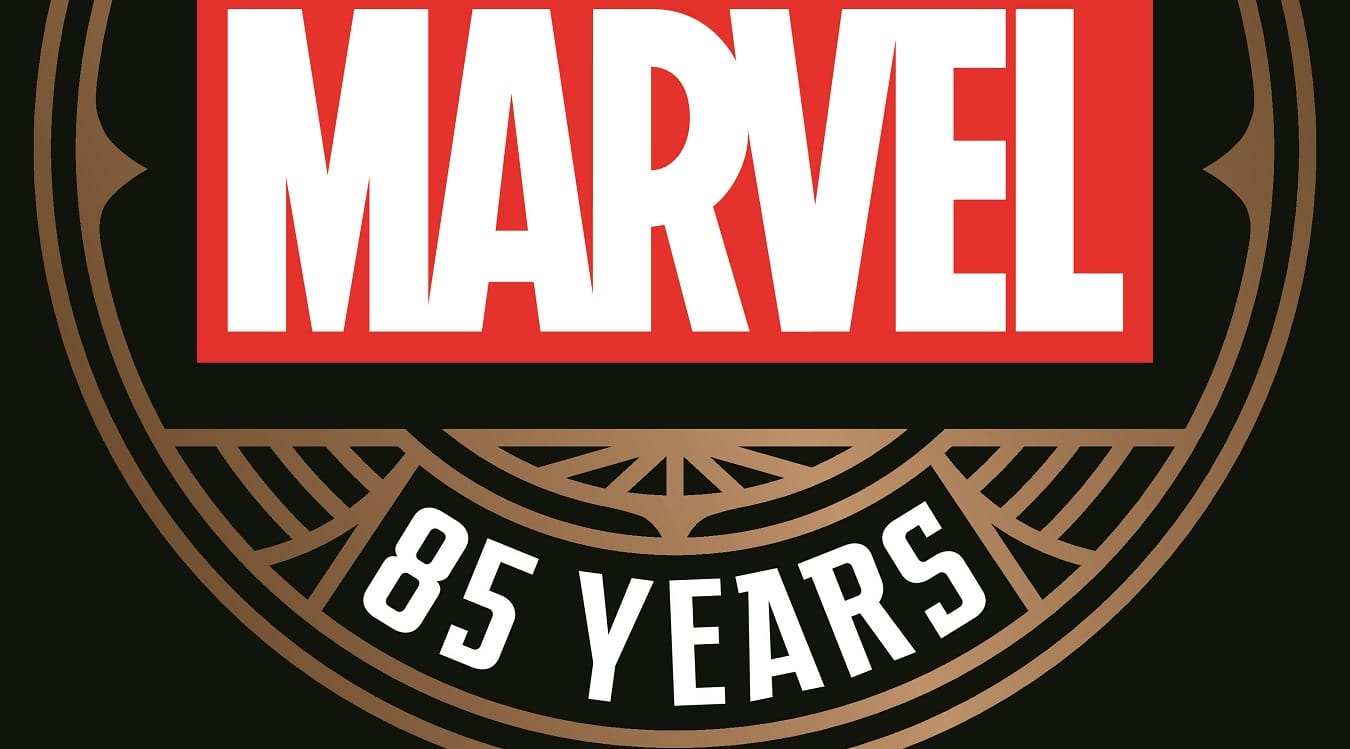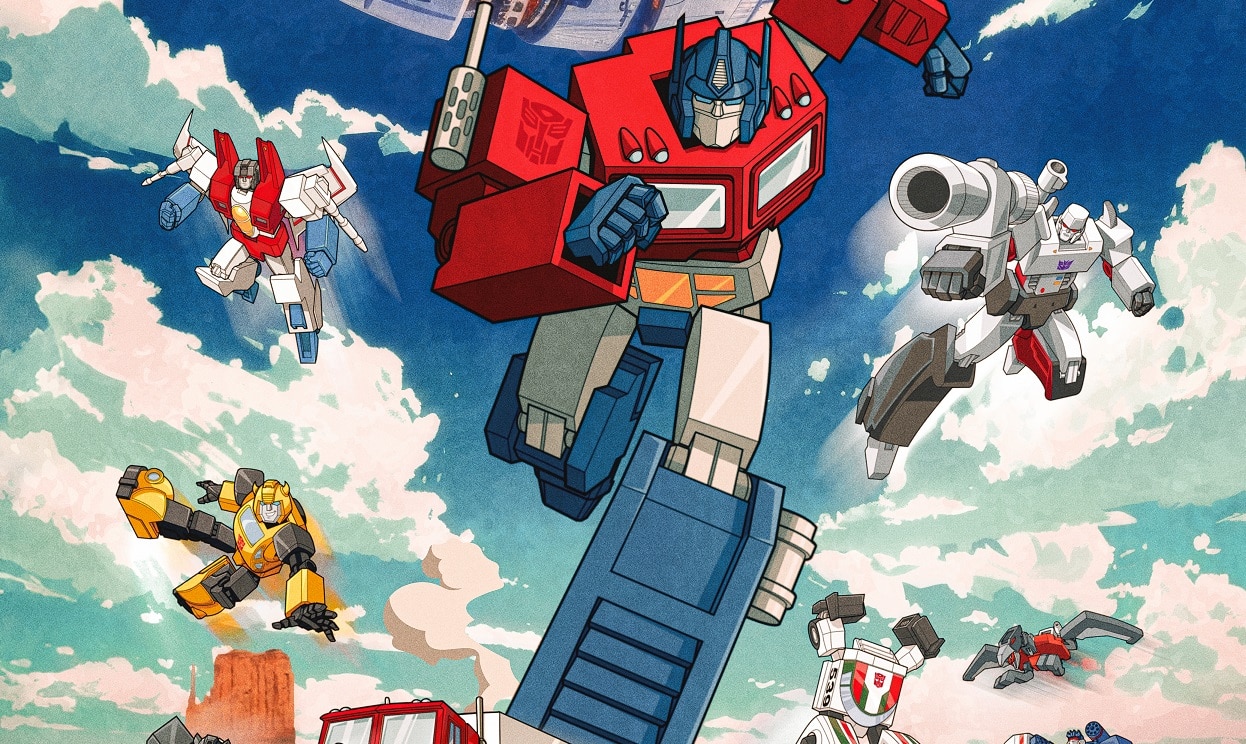A truly epic crossover from BOOM! Studios and IDW Publishing hits stands today: Mighty Morphin Power Rangers/Teenage Mutant Ninja Turtles #1, which has the two iconic teams working together to save the world. Written by Ryan Parrott and illustrated by Simone di Meo, with letters by Ed Dukeshire and colors by Walter Baiamonte and Igor Monti, this limited series allows the creative team to play outside of current comics continuity for both teams in a way that’s approachable for casual fans as well as diehard ones.
In case you missed it, here’s the solicit text for the debut issue:
THE MIGHTY MORPHIN POWER RANGERS AND THE TEENAGE MUTANT NINJA TURTLES MEET FOR THE FIRST TIME! The Power Rangers arrive in New York City to find Tommy Oliver (a.k.a. The Mighty Morphin Green Ranger) but soon discover he’s joined forces with the villainous Shredder and the Foot Clan! As the Rangers are sent reeling by this betrayal, they ‘re confronted by another (fr)enemy… the Teenage Mutant Ninja Turtles! Can these heroes find a way to work together to defeat the bad guys and save the world from total destruction?!
So, how did Parrott go about crafting the script for this world? What’s his ultimate goal? Which team would he join? And who does he think is a better leader?
The Beat hopped on the phone with him to ask all of our most burning questions about Mighty Morphin Power Rangers/Teenage Mutant Ninja Turtles. Check out what he had to say below.
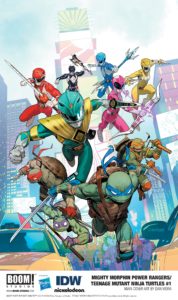
Samantha Puc: To start off, how did you approach crossing over these two really iconic teams?
Ryan Parrott: My approach was to go back in time and talk to my 10 year-old self and just ask him all of the things he wanted to see when he was a little kid and played with all the action figures. I owned all of the action figures for both of these franchises. I put my parents basically in the poor house. I just thought, I loved both of these franchises so much growing up; I want to see all the things that I played with and all the things that I wanted to see.
I’m also the weird kid who would not have my action figures fight. They would just go and hang out and play basketball, so for me, half of this process was just, “How do I get the Power Rangers and the Ninja Turtles together so that they can talk about their favorite pizza toppings? How do they train?” I like character stuff as much as I like the big action pieces, which I’m not saying aren’t in [the series], but I tried to balance the two.
So, that was my approach. What are all the questions I wanted the Turtles to ask the Rangers, and what are all the questions I wanted the Rangers to ask the Turtles? Hopefully, those are things that other people growing up like as well.
Puc: When you were growing up, were you more of a Power Rangers or more of a TMNT fan? Were you equally enamored with both?
Parrott: I like them both equally, is my professional answer. But I will say that age-wise, I think I was a little bit [too old] for Power Rangers. Turtles was a little bit younger for me, so that was the sweet spot — I think I was seven or eight when it came out, and I was 13 or so when Power Rangers came out, so I was starting to age up a little bit. I had all of the action figures. My friend and I would basically trade toys every week. We had this giant set of stuff; I’d go over to his house and he’d have a bunch of action figures and I had other ones and we’d play and bring them all together. When I was eight, that was what I did.
I saw the Ninja Turtles in concert. It was called the “Coming Out of Their Shells” Tour. So yes, I was a fan.
Puc: You’ve spoken to this a little bit in terms of balancing the character moments with the action sequences, but from a storytelling perspective, what is your overall goal for this series?
Parrott: That’s a good, good question. That was kind of the point of what we were trying to figure out, like, what are the most interesting elements of these two groups coming together? And the one thing I did like was that the Ninja Turtles had appeared already in Power Rangers in Space. What I thought was great was that it means they already exist in the same universe; I didn’t have to spend the time it takes to figure out why they stepped into an interdimensional portal, or whatever.
In this world, the Turtles know who the Rangers are, but the Rangers don’t know who the Turtles are. The Rangers are fighting to save the world out in the open, but the Turtles are saving the world from behind the scenes. I thought, “Isn’t that an interesting contrast?” So [it was] the idea of these two groups coming together and discovering that not only do they share a lot of the same responsibilities and problems, but that they also have to [solve them] in two different ways. And how can I have them see the world through each others’ eyes a little bit? That’s the center of the story for me.
They share so much. To describe both series, I could say, “It’s a group of color-coded teenagers who fight like demons and monsters and an evil despot trying to take over the world.” I’m describing both series in the exact same way, and I thought leaning into that similarity but also finding the slight difference would open the characters’ eyes and allow them to grow.
Puc: Does this crossover fit into comics continuity at BOOM! or IDW with the current Power Rangers and Ninja Turtles runs?
Parrott: They can fit in, but where they fit in directly in time, I’ve sort of left open. I wanted to try to make this story as accessible to both fanbases [as possible]. For people reading my Power Rangers run, I can’t rely on the idea that they’ve been reading the other series at the same time and also vice versa.
It made sense for me to try and write the story from the point of view of the shows I remember growing up on, and making it a love letter to them in the sense that if you watched Power Rangers or Teenage Mutant Ninja Turtles, you can step into this story and understand everything. That’s one of the reasons that some characters are not in it; that’s not to say that they aren’t down the line, but it makes sense not to try and throw all that continuity in, because it would have been very confusing to people who liked the shows growing up but have no idea who the new Ninja Turtle is. Or like, “Who the heck is Matthew?”
Puc: Does that mean Jennika won’t be making an appearance, at least not in the immediate future?
Parrott: She is not in this particular story. That doesn’t mean that if we do a sequel that she couldn’t pop up.
Puc: Without giving away spoilers, are there any moments in this series that you’re particularly fond of or that you’re really looking forward to readers getting to experience?
Parrott: I think when we get into the middle of the story, one of the fun parts of the series was finding interesting pairings between the Rangers and the Ninja Turtles, and having conversations and interactions that I had only dreamed of. There are some obvious ones, like Zack and Michelangelo have a lot in common because they’re both sort of the wisecracking guys, but there’s a lot of fun that they have. Having them fight side by side, I can play with that banter.
And then we get some interesting pairings I didn’t expect, like Raphael and Trini. I think most people would expect either Raphael and Tommy or Raphael and Jason, but as I was writing it, I discovered that Trini is sort of the soul of the team. Raphael is also sort of the soul of the team, even though he doesn’t like to admit it. A lot of the ideas and themes of the story came out of their interactions, which I wasn’t expecting. That’s one of those things where the characters actually guide you to where you need to be.
The other fun thing is, because this all exists in the same universe, Donatello is a smart guy; I have a feeling he’s a little bit of a Power Rangers superfan. He knows a lot about the Power Rangers, but it’s super helpful because he gets to ask questions that I, as a fan, would want to know. For instance, in one of the issues, he asks Billy why the Green Ranger is able to play the flute through a metal faceplate. I thought, “Well, that’s been something I always wondered, so maybe Donatello wondered too.” So that’s been half the fun, is getting to play with those interactions, as well.
Puc: I am curious: who do you think is a better leader, Leonardo or Jason?
Parrott: This is a trap! I can feel it. This is a trap. I think Leo and Jason both have their own unique leadership styles. [Laughs] Yeah, I’m not falling for that one. I’ll get hate mail. Not doing that one.
Puc: OK, fair enough. If you could choose between joining the Ninja Turtles or joining the Rangers, which team would you want to be on and which color would you wear?
Parrott: You’re just trying to get me in trouble. I don’t appreciate this.
Puc: You could also pick both!
Parrott: I could pick both? Well, I would pick both for unique reasons. To become a Turtle — I think it would be amazing to get mutated and get to wear… What color would I wear? I can’t wear yellow anymore. Green would be redundant. That would just be awkward, wouldn’t it? There’s no black, right? I’d wear black! With like a black hoodie thing. That would be cool. But I feel like it would be fun to be a Turtle for like, 20 minutes, and then it would be like, “Now I just feel awkward and weird and I miss my five fingers.” So I would enjoy it for a little while.
One of the things I’ve always loved about the Power Rangers and why I think it’s such a cool franchise — and something I like as a writer, as well — is the idea that anybody can be a Ranger. If you’re good and pure of heart and live your life by a certain set of principles, the idea that you could be worthy enough to a power and join up with that team and be part of that group of strangers… I think the sensibility of being a Ranger is so cool. Every time I go to a con, I see people doing the pose all the time. I think there’s something cool about that. It makes you feel like you’re a part of a community that anybody could be part of. In the same way with Star Wars where anybody can be a Jedi, I like the idea that anybody could be a Ranger.
I think that’s what makes both teams special.
Puc: Can you speak to what it’s been like working with the creative team on this book?
Parrott: Oh, man. The greatest thing ever, as a writer, is when you spend so much time making a story in your head, and then you send it out in the world and it’s like, “Oh, man. I hope — I have no idea if this works.” And then there’s that great moment when the artist starts to send you back pages, and you see your brain projected onto the paper in ways that are 10 times better than you ever imagined.
That’s what it’s like working with Simone. Simone’s done such an incredible job taking all the ideas that I had and making them 10 times better. The thing that made me feel really great is that, in the very beginning, he sent over his first sketches of the Turtles, right? What he had done was augment the masks a little bit to be not just standard masks, but to actually try to convey the personalities of the Turtles. The minute I saw that, I was like, “That’s brilliant!” When I get the pages, they’re black and white, and I knew who all the Turtles were immediately, just from the looks of the masks and the gestures he would give them. So I knew when he was thinking at that level of detail and putting that much thought process into crafting the Turtles, I knew it was going to be fine. He’s already been doing Rangers for a while, so I knew that wasn’t going to be a problem.
That’s been half the fun. As you write a comic book and work with an artist, the first issues are always a little heavy because you’re trying to describe everything, but by the third or fourth issue if you have a good vibe, scripts get really thin because you don’t have to describe anything anymore. You just trust them. So my scripts at the end are bare bones. They’re just outlines. I just trust him to draw stuff. He’s just been amazing.
The colors are fantastic. Everything about this process; I’ve been so fortunate and so lucky to work with such incredibly talented people.
Puc: Awesome. Is there anything else you’d like to add?
Parrott: I hope people like it! It’s my childhood too, so I hope that I wrote it with respect and hopefully added a little bit to the mix. If people like it, hopefully we’ll get to do another one.
Mighty Morphin Power Rangers/Teenage Mutant Ninja Turtles #1 is available in stores now. To keep up with Ryan Parrott on social media, follow him on Twitter @ThatRyanParrott.
Note: Art in the featured image is by Dan Mora for issue #3.


